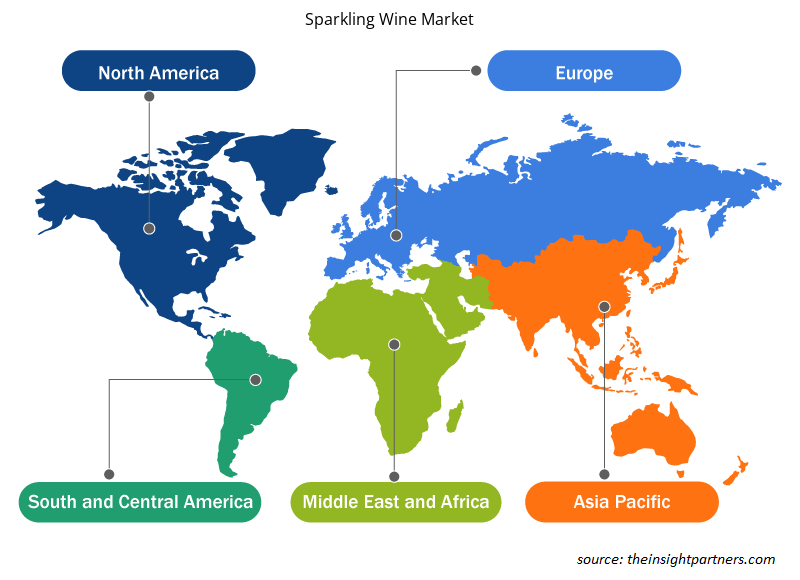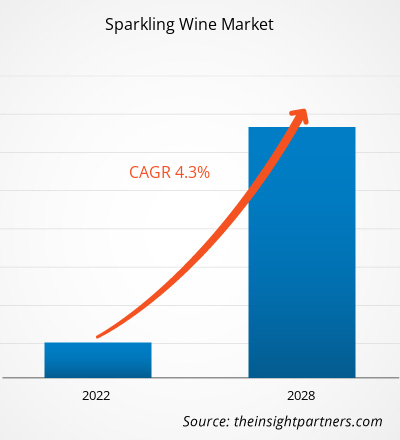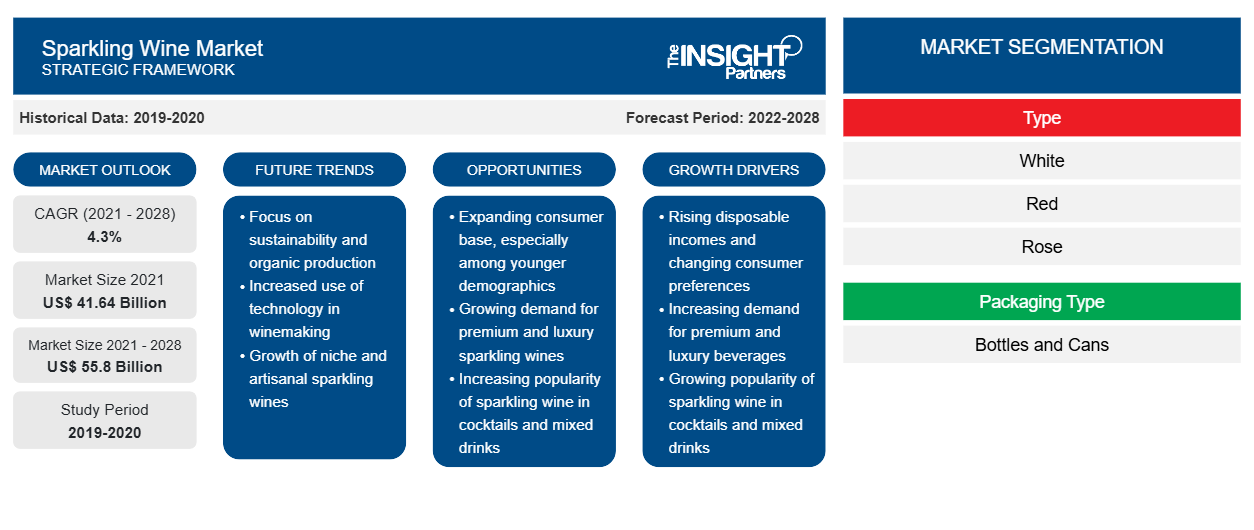El mercado del vino espumoso se valoró en 41.640 millones de dólares en 2021 y se proyecta que alcance los 55.800 millones de dólares en 2028; se espera que crezca a una CAGR del 4,3% entre 2021 y 2028.
El vino espumoso es una variante del vino con un alto contenido de dióxido de carbono, lo que le aporta más burbujas. El champán es uno de los tipos de vino espumoso más populares. Es el vino elaborado en la región de Champaña en Francia; sin embargo, muchos productores de vino espumoso en los EE. UU. usan este nombre para sus productos fabricados localmente.
En 2020, Europa representó la mayor parte del mercado de vino espumoso . La Unión Europea (UE) tiene la mayor concentración de productores de vino espumoso. Según el Instituto del Vino y la Vid, la UE representa entre el 70% y el 80%, en volumen, de la fabricación mundial de vino espumoso desde el año 2000. Según los expertos de la industria, Europa exporta un mayor volumen de vino espumoso que de vino tranquilo en los mercados internacionales. La región tiene una larga e ilustre historia de elaboración de vino. Los amantes del vino de todo el mundo prefieren el vino espumoso europeo debido a sus sabores, gustos y métodos de preparación únicos. Además, la creciente preferencia por las bebidas menos alcohólicas, la creciente influencia de las celebridades en los estilos de vida de las personas, la inclinación por los alimentos y bebidas preparados y la tradición de descorchar una botella de champán o vino espumoso durante las festividades y celebraciones, entre otros, justifican el dramático aumento de la demanda de esta categoría de vino. Europa tiene un mercado de vino espumoso altamente establecido, que consta de varios destiladores destacados y pequeños.
Los productores de vino espumoso se han visto afectados significativamente por la escasa disponibilidad de trabajadores durante la pandemia de COVID-19, lo que ha obstaculizado su capacidad de producción. Además, el cierre de los mercados mayoristas ha obligado a los fabricantes a depender principalmente de supermercados y distribuidores de comercio electrónico para vender sus productos de vino espumoso. A pesar de la pandemia, se ha producido un aumento en las ventas de vino rosado y espumoso.
Personalice este informe según sus necesidades
Obtendrá personalización en cualquier informe, sin cargo, incluidas partes de este informe o análisis a nivel de país, paquete de datos de Excel, así como también grandes ofertas y descuentos para empresas emergentes y universidades.
-
Obtenga las principales tendencias clave del mercado de este informe.Esta muestra GRATUITA incluirá análisis de datos, desde tendencias del mercado hasta estimaciones y pronósticos.
Perspectivas del mercado
Aumento de la popularidad del vino espumoso
Los rápidos cambios socioeconómicos y la urbanización acelerada están impulsando la demanda de vino espumoso. Con el continuo aumento del nivel de vida y del poder adquisitivo, los clientes desean comprar artículos lujosos y de alta calidad. Además, sus hábitos alimentarios y preferencias gastronómicas cambian con estos cambios en el estilo de vida. Por lo tanto, la demanda de vino espumoso en fiestas, bodas y reuniones sociales está en aumento. Con la creciente preferencia por bebidas con bajo o ningún contenido de alcohol, la popularidad de este vino está aumentando entre los millennials, los adolescentes y las poblaciones trabajadoras, y entre los solteros y las personas que viven en albergues. Además, el uso generalizado de las redes sociales e Internet está afectando significativamente a todas las generaciones, mientras que el aumento del número de fiestas y eventos sociales está contribuyendo al aumento del consumo de vino espumoso a nivel mundial, principalmente en países desarrollados como Estados Unidos, Canadá, México, Alemania, Francia e Italia, impulsando así el crecimiento del mercado del vino espumoso.
Información sobre tipos
Según el tipo, el mercado del vino espumoso se segmenta en tinto, blanco y rosado. En 2020, el segmento blanco representó la mayor participación de mercado. El vino blanco se elabora con uvas Moscato Bianco de la región vinícola del Piamonte en Italia. Su producción se concentra principalmente en Alba y la provincia de Asti en el norte de Italia. Las burbujas son causadas por la fermentación natural, que puede ocurrir en la botella o en un tanque grande. La fermentación ocurre cuando se agrega azúcar al vino y la levadura actúa sobre el azúcar, generando dióxido de carbono. Las burbujas se forman en el vino como resultado del dióxido de carbono atrapado dentro de un ambiente cerrado.
Entre los actores clave del mercado del vino espumoso se encuentran Bacardi & Company Limited; Bronco Wine Co.; Casella; Constellation Brands, Inc.; Henkell Freixenet; Chandon; Schramsberg Wineyards; Pernod Ricard Winemakers; The Sparkling Wine Co.; Treasury Wine Estates Ltd; Bottega Spa; Campari Group; y Codorniu.
Perspectivas regionales del mercado del vino espumoso
Los analistas de Insight Partners explicaron en detalle las tendencias y los factores regionales que influyen en el mercado de vinos espumosos durante el período de pronóstico. Esta sección también analiza los segmentos y la geografía del mercado de vinos espumosos en América del Norte, Europa, Asia Pacífico, Oriente Medio y África, y América del Sur y Central.

- Obtenga datos regionales específicos para el mercado del vino espumoso
Alcance del informe sobre el mercado de vinos espumosos
| Atributo del informe | Detalles |
|---|---|
| Tamaño del mercado en 2021 | US$ 41.64 mil millones |
| Tamaño del mercado en 2028 | 55.800 millones de dólares estadounidenses |
| CAGR global (2021-2028) | 4,3% |
| Datos históricos | 2019-2020 |
| Período de pronóstico | 2022-2028 |
| Segmentos cubiertos |
Por tipo
|
| Regiones y países cubiertos |
América del norte
|
| Líderes del mercado y perfiles de empresas clave |
|
Densidad de actores del mercado de vinos espumosos: comprensión de su impacto en la dinámica empresarial
El mercado de vinos espumosos está creciendo rápidamente, impulsado por la creciente demanda de los usuarios finales debido a factores como la evolución de las preferencias de los consumidores, los avances tecnológicos y una mayor conciencia de los beneficios del producto. A medida que aumenta la demanda, las empresas amplían sus ofertas, innovan para satisfacer las necesidades de los consumidores y aprovechan las tendencias emergentes, lo que impulsa aún más el crecimiento del mercado.
La densidad de actores del mercado se refiere a la distribución de las empresas o firmas que operan dentro de un mercado o industria en particular. Indica cuántos competidores (actores del mercado) están presentes en un espacio de mercado determinado en relación con su tamaño o valor total de mercado.
Las principales empresas que operan en el mercado del vino espumoso son:
- Bacardi y Compañía Limitada
- Compañía de vinos Bronco.
- Casella
- Marcas Constellation, Inc.
- Henkell Freixenet
Descargo de responsabilidad : Las empresas enumeradas anteriormente no están clasificadas en ningún orden particular.

- Obtenga una descripción general de los principales actores clave del mercado del vino espumoso
Informe Destacado
- Tendencias progresivas de la industria en el mercado mundial de vinos espumosos para ayudar a los actores a desarrollar estrategias efectivas a largo plazo
- Estrategias de crecimiento empresarial adoptadas por empresas en mercados desarrollados y en desarrollo
- Análisis cuantitativo del mercado mundial de vinos espumosos de 2019 a 2028
- Estimación de la demanda de vino espumoso por parte de los consumidores
- Análisis PEST para ilustrar la eficacia de los compradores y proveedores que operan en la industria para predecir el crecimiento del mercado
- Avances recientes para comprender el escenario competitivo del mercado y la demanda de vino espumoso
- Tendencias y perspectivas del mercado junto con los factores que impulsan y restringen el crecimiento del mercado del vino espumoso
- Comprensión de las estrategias que sustentan el interés comercial en el mercado, ayudando así en el proceso de toma de decisiones de los actores del mercado.
- Tamaño del mercado de vinos espumosos en varios nodos del mercado
- Descripción detallada y segmentación del mercado mundial de vinos espumosos, así como su dinámica industrial
- Tamaño del mercado del vino espumoso en varias regiones con oportunidades de crecimiento prometedoras
Mercado de vinos espumosos por tipo
- Blanco
- Rojo
- Rosa
Mercado de vinos espumosos por tipo de envase
- Botellas
- Latas
Mercado de vinos espumosos por canal de distribución
- Supermercados e Hipermercados
- Tiendas especializadas
- Venta minorista en línea
- Otros
Perfiles de empresas
- Bacardi y Compañía Limitada
- Compañía de vinos Bronco.
- Casella
- Marcas Constellation, Inc.
- Henkell Freixenet
- Viñedos de Schramsberg
- Enólogos de Pernod Ricard
- La Compañía de Vinos Espumosos.
- Fincas vinícolas del Tesoro Ltd.
- Chandon
- Análisis histórico (2 años), año base, pronóstico (7 años) con CAGR
- Análisis PEST y FODA
- Tamaño del mercado, valor/volumen: global, regional y nacional
- Industria y panorama competitivo
- Conjunto de datos de Excel
Informes recientes
Informes relacionados
Testimonios
Razón para comprar
- Toma de decisiones informada
- Comprensión de la dinámica del mercado
- Análisis competitivo
- Información sobre clientes
- Pronósticos del mercado
- Mitigación de riesgos
- Planificación estratégica
- Justificación de la inversión
- Identificación de mercados emergentes
- Mejora de las estrategias de marketing
- Impulso de la eficiencia operativa
- Alineación con las tendencias regulatorias























 Obtenga una muestra gratuita para - Mercado de vinos espumosos
Obtenga una muestra gratuita para - Mercado de vinos espumosos